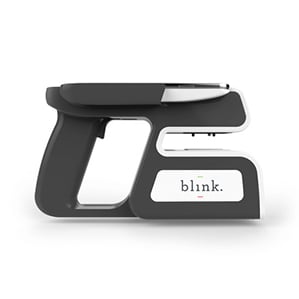A Smartphone Eye Exam Service Launches in New York
Your next eye exam could be done with gadgets that connect to a smartphone and fit into a small suitcase—and there may not be a doctor or optometrist in the room.

A service called Blink is launching today in New York that will bring an eye exam to your home or office for $75, administered by a technician who uses a trio of handheld devices that take the place of the bulky autorefractor, lensmeter, and phoropter you may have seen in an eye doctor’s office. The technician will send the results to an optometrist, who will write a prescription if necessary and e-mail it to you (in the U.S., only ophthalmologists and optometrists can legally write eyeglass prescriptions).
Blink is the product of EyeNetra, a startup that has been working for several years on smartphone-connected eye-exam tools (see “When Smartphones Do a Doctor’s Job”). The idea behind Blink is to make eye exams more convenient (and in some cases more affordable) by redesigning the expensive, typically immovable equipment that usually crowds a doctor’s or optometrist’s office as much cheaper, smaller tools that rely on a smartphone to do some of the work.
The Blink tools join a growing number of smartphone-connected diagnostic gadgets that companies hope will make it simpler and cheaper for anyone—not just doctors—to diagnose health problems. Eventually, this could reduce health-care costs, and make it easier for people to get medical help even if they don’t live near a doctor’s office.
Blink’s eye exam tools include a black device that looks sort of like a View-Master with a smartphone bolted to it, which takes the place of an autorefractor for measuring your level of focusing error. The device uses a Blink app shown on the smartphone’s display to shine red and green beams of light at your eyes. You line up these beams with a dial and the app figures out your refractive error by measuring the difference between where the beams are on the screen and how much you adjust them. (EyeNetra showed off a prototype autorefractor in 2013.)
Another device also uses a smartphone, though this time to do the job of a lensmeter, which measures the prescription strength of your existing glasses. To do this, a smartphone running the Blink app is placed in the device (which looks kind of like a space-age staple gun), eyeglasses are slid between the phone and the device, and a picture is taken of a pattern beneath the eyeglass lens with the phone’s camera.
A third device stands in for a phoropter, which helps determine the specific strength of the lens prescription you need by letting you try different lenses and settings while looking at an eye chart.
The Blink screening process takes about 20 minutes, says David Schafran, cofounder and chief product officer for Blink and EyeNetra. If the Blink app determines you need an eyeglass prescription, the technician will send results of the screening to an optometrist, who will send you a prescription within 24 hours.
Schafran says Blink has been testing its tools with hundreds of people for over a year, and thus far it has proved as useful as getting an eye exam from a doctor or an optometrist. “There’s no meaningful difference between our approach and what’s commonly done today,” he says.
For now, Blink is offering exams only for eyeglasses prescriptions, and only in certain neighborhoods in New York City, but Schafran says Blink plans to branch out to other cities.
Keep Reading
Most Popular
Large language models can do jaw-dropping things. But nobody knows exactly why.
And that's a problem. Figuring it out is one of the biggest scientific puzzles of our time and a crucial step towards controlling more powerful future models.
The problem with plug-in hybrids? Their drivers.
Plug-in hybrids are often sold as a transition to EVs, but new data from Europe shows we’re still underestimating the emissions they produce.
Google DeepMind’s new generative model makes Super Mario–like games from scratch
Genie learns how to control games by watching hours and hours of video. It could help train next-gen robots too.
How scientists traced a mysterious covid case back to six toilets
When wastewater surveillance turns into a hunt for a single infected individual, the ethics get tricky.
Stay connected
Get the latest updates from
MIT Technology Review
Discover special offers, top stories, upcoming events, and more.